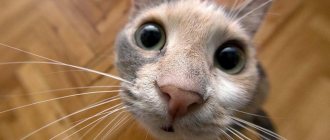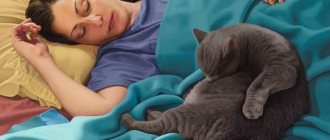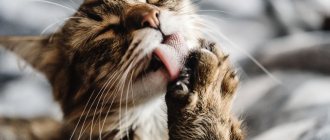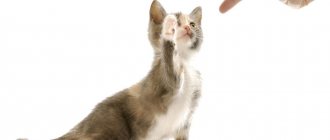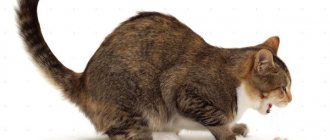Everyone knows that purrs are smart creatures. They are on their own, even though they are fawning. In most cases, they simply beg for food and, accordingly, are very selfish. However, there are also individuals for whom human attention is very important.
They are not afraid and calmly make contact. Although you shouldn’t always trust people, because they can offend you. It especially hurts when they grab the tail. It is easier to catch the beast with it. Some non-humans not only pull, but also lift the poor animal by this part of the body.
The meaning of the tail in the life of cats
To understand the dangers of pulling a cat's tail, it is important to understand the basic functions of this part of the body. It is necessary for a full-fledged cat’s existence and performs the following tasks:
- serves as a balance regulator when jumping and moving in height;
- if you fall, it helps you “steer out” and fall straight on your paws, avoiding injury;
- is a means of communication: through movements of the tail, the cat communicates with its relatives and expresses its emotions towards its owners.
There are breeds whose standard implies a short tail or almost no tail. For example, tailless Manxes have 2–3 tail vertebrae (while most breeds have 20–27).
These cats have more developed hind limbs, which partly compensate for their natural taillessness. If an animal loses its tail in adulthood, its motor and communication functions will be impaired.
Why do cats have tails?
The tail is a very important part of the body for domestic felines. It really helps cats navigate space and establish coordination. Thanks to these features, cats can:
- climb trees freely;
- jump and stay on top;
- when falling from a height, successfully land on your feet;
- get through narrow openings;
- walk on narrow surface areas;
- catch small rodents and insects.
Of course, there are tailless and short-tailed cat breeds, representatives of which perfectly balance and land on the surface without the help of a tail. Most likely, they are satisfied with his small likeness, which is also significant. But still, long-tailed cats are more agile and nimble compared to their relatives.
The tail helps cats express their emotions and feelings. Surely, you have noticed more than once how your pet, when greeting you, shows joy by raising its tail high in a “pipe”. If the cat sits with her tail wrapped around her paws, this is also a good sign, hinting at a friendly disposition towards you. But when preparing for some reckless act, the animal usually waves its tail in different directions. A very frightened or aggressive cat is usually identified by a tail with tousled hair.
Thanks to this fluffy appendage, heat-loving cats keep warm by curling up in a ball and as if covering themselves with it.
Spine part
Cat owners know how carefully their pets treat their own tail, protecting it from careless touches of guests and household members. And this is no coincidence, because the tail contains many nerve endings necessary for the normal functioning of the animal.
Even the slightest injury in this area causes unbearable pain to the pet. For this reason alone, for caring owners, the answer to the question of whether it is possible to pull a cat’s tail is obvious.
In addition, it should be borne in mind that the tail is an extension of the spine. It consists of individual vertebrae that are connected to each other by cartilage and joints that provide mobility.
The first 5–8 caudal vertebrae are absolutely identical in structure to the elements of the main parts of the spine (that is, they have a body and an arch); in the remaining parts there is no spinal canal.
It is necessary to pay attention to the fact that cats are not docked for aesthetic purposes, like dogs. Any damage to this area compromises the functioning of the animal's nervous system. The health consequences can be quite serious, including complete loss of sensation in the back of the body.
Is tail pulling dangerous?
For the animal, this is first and foremost. The cat’s tail, as we found out above, consists of a fairly large number of vertebrae and is the coordinator of the musculoskeletal system.
What happens if you handle your pet's tail carelessly? First, pulling a cat's tail causes him pain. Cats don't like having their tail touched. Notice how the pet reacts nervously as soon as the owner touches this part of the body. He pulls back, begins to get nervous, or even tries to get away from the owner.
A cat's tail is the most sensitive part of the body. It contains a lot of nerve endings. Therefore, it is not surprising that, having felt a tug on its tail, the animal leaves and hides its tail. Or he simply fights back, rushing at the offender with claws extended.
If you pull a cat's tail, it may "shit"
In search of an answer to the question of what will happen if a cat is pulled by the tail, many have probably come across the popular belief that the animal will then begin to “shit anywhere.” You shouldn’t brush this off as ridiculous superstitions about empty buckets and haircuts during pregnancy.
In this case, the conclusion of “collective intelligence” has good grounds. As mentioned above, the tail is part of the spine, and damage to the spinal column can cause complete or partial paralysis of the lower extremities, fecal and urinary incontinence.
If your cat was regularly subjected to unceremonious treatment by members of the household, and then suddenly began to relieve himself outside of specially designated places, you should not be angry with him, much less punish him. Perhaps these are the consequences of a spinal injury resulting from a sharp tug on the tail.
The tail is an indicator of the cat's emotions
Most often, a cat twitches its tail to communicate its mood. Depending on how and how actively she begins to move it, the owner can guess what emotions his pet is experiencing:
- Excess of feelings. Often a cat's tail twitches when a person pets the animal. Combined with purring, this means that the cat is absolutely happy. He is satisfied with the owner's attention and hurries to tell him about it.
- Interest in something. The cat's tail stands upright when the pet is happy and expects something pleasant (for example, it is time to feed). But when he begins to smoothly move it up and down, this is a sign that the cat is interested in some thing or object. He will walk around it, sniff it, try to catch it. It could be anything: a fly flying by, a new toy, a bag of groceries.
- Irritation. Experiencing such emotions, the cat begins to rhythmically jerk its tail left and right. This is how she shows that the current situation is unpleasant for her. For example, a pet may feel that the timing for affection is poorly chosen.
- Fear, panic. It is not difficult for a person to determine that a cat is very scared - the animal twitches its tail, hitting it on the floor with all its force. His whole body is shaking, his pupils are dilated, and the cat itself can make plaintive sounds. At such moments, the pet should not be touched. The best thing the owner can do is to eliminate the situation or object that frightened the animal.
When should you contact a veterinarian?
Serious damage to the tail is usually visible to the naked eye. You should seek veterinary help if your pet has the following symptoms:
- visible break or break in the tail area;
- painful reaction to touch;
- the tail is hot and inflamed, there is severe swelling;
- problems with the hind limbs, loss of balance, gait disturbance;
- the animal is unable to support its tail, it hangs like a whip;
- loss of previously formed neatness skills: involuntary defecation or urination.
Twitching of the cat's tail and back
Sometimes cats not only twitch their tail, but also their back. There are several reasons that cause this animal behavior. A cat constantly jerks its tail and rear part of its body in the following cases:
- during puberty she has a sexual desire, but there is no way to satisfy it;
- the animal has fleas;
- the pet has been struck by cancer - a tumor has arisen in the spinal cord or brain.
In addition, the cat may twitch its back and tail due to neurosis. In veterinary medicine it is called hyperesthesia syndrome. Suffering from this disease, the animal begins to lick its paws, back, and anus for hours. His fur becomes wet from saliva and does not have time to dry before the next wash. Such actions of the pet indicate nervous exhaustion, lack of attention from the owner, and severe stress.
Excessive licking of the body provokes dermatitis of the animal. Due to constant itching, the cat will begin to twitch its back and tail, wanting to get rid of the unpleasant sensations. If the cat owner ignores this problem, then patches will form in the licking areas, and a fungal disease may develop in the future.
Domesticated representatives of the cat family are distinguished by their complacent disposition, so they are loved by all family members, regardless of age. If your cat's back is twitching and she begins to behave in an atypical manner, you should contact your veterinarian for a series of tests.
When a cat's back twitches, it is very important to determine the cause of the problem. It is especially necessary to carefully monitor animals that have the opportunity to roam freely on the street. For example, if a cat’s tail and back are twitching, she is periodically very irritable and even aggressive, eats food but refuses to drink, it is necessary to urgently take her to the veterinarian.
If the cause of convulsive twitching of the back and tail lies precisely in rabies infection, but the owners do not pay attention to this, the situation can develop into a potentially dangerous situation for humans. As this infectious disease develops, the cat may begin to foam at the mouth, it becomes aggressive and attacks all living things, which may well end up infecting people who come into contact with the animal.
Twitching of the back and tail is often observed in cats during the breeding season. An animal may express irritation with this behavior. Twitching of the back and tail is especially common in cats that do not have the opportunity to walk freely and fully participate in mating games.
Some purebred cats may develop a pathological condition called hyperesthesia syndrome. This disorder most often occurs in young animals. Currently, the reasons for the development of this pathological condition have not been identified, so it is extremely difficult to treat. Cats suffering from this syndrome are hypersensitive and irritable.
They constantly lick the fur in the tail and spine area. Such excessive grooming of fur on certain parts of the body subsequently leads to the development of dermatitis, which causes the animal even more discomfort. Damage to the skin by pathogenic microflora causes severe itching.
In addition, this pathological condition is accompanied by attacks of aggressiveness, and not only other pets, but also people can be attacked. In the vast majority of cases, treatment of cats suffering from hyperesthesia syndrome is carried out using special medications. First of all, anticonvulsants and sedatives are prescribed. Your veterinarian may recommend eliminating all triggers that may cause your pet to become irritable.
Common fleas can cause twitching of a cat's back and tail. To eliminate such manifestations of parasite damage, it will be enough to carry out targeted treatment of the animal using a special collar or insecticidal drops for application to the withers.
In rare cases, involuntary twitching of a cat's back and tail can be caused by cancerous tumors located in the spinal cord or brain. In such a situation, treatment is carried out surgically, but the prognosis is usually unfavorable.
Useful materials:
- Cutaneous horn General description of the disease Cutaneous horn on the forehead or face (ICD 10 code - L57.0) -...
- Itching and odorless discharge Main causesBefore considering the factors that provoke the appearance of discharge that has a sour odor, it is necessary to immediately note...
- Discharge in women What kind of discharge between menstruation is considered normal? Female discharge normally consists of mucus from the cervical canal, dead...
Injury Prevention
As you know, any disease is easier to prevent than to treat. Therefore, in conclusion, let’s talk about preventive measures.
- Be careful when handling the animal. If you need to catch him, don't grab his tail - it's dangerous!
- Limit your pet's access to the street. If you have a private home, equip heavy doors with a soft-closing mechanism.
- Explain clearly to children and other family members why it is wrong to pull a cat's tail, using arguments appropriate to their level of understanding.
- If the baby is very small, do not leave the cat alone with him: this can be dangerous not only for the pet, but also for the child himself.
And remember, we are responsible for those we have tamed. Develop in children love and compassion for all living things from an early age - this will make them more responsible and happy!
The cat's tail is easily injured and broken.
Despite the fact that cats are quite sensitive to their tail and do not stick it anywhere, it can also be injured. Moreover, quite easily, since it consists of flexible cartilage, vertebrae and joints, it can be broken. But recovery will take quite a long time, and sometimes he may not recover at all. Therefore, if you have small children at home and a cat, then teach your child from birth to take care of his furry friend, and especially his tail, without allowing the animal to be pulled or pulled by it.
A pet's cat's tail is not at all for beauty; it is an important organ, without which the animal simply may not survive. It performs functions such as maintaining balance, communication with other pets, and also a mood regulator. The tail also helps the cat keep warm, since in the cold season he can cover his frozen nose with it. Therefore, you should not drag the animal by this organ, even if it has done something wrong.



